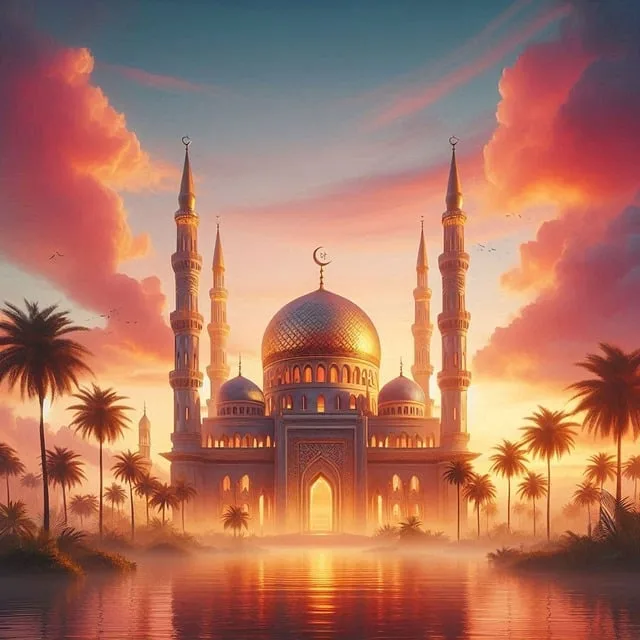First up, we have the Great Mosque of Mecca, or Masjid al-Haram. Imagine standing in a vast courtyard, surrounded by millions of fellow worshippers, all facing the Kaaba. It’s like being part of a massive, spiritual family reunion! This mosque is the heart of Islam, where millions flock each year for Hajj, a pilgrimage that’s a cornerstone of the faith.
Then there’s the Al-Masjid an-Nabawi in Medina, the second holiest site. Picture a serene oasis where the Prophet Muhammad is buried. The mosque’s green dome is iconic, and the atmosphere is filled with peace and reflection. It’s a place where you can almost feel the whispers of history echoing around you.
Don’t forget about the Sultan Ahmed Mosque, or the Blue Mosque, in Istanbul. With its stunning blue tiles and majestic minarets, it’s like stepping into a fairy tale. The way the light filters through the stained glass creates a magical ambiance that leaves visitors in awe. It’s a perfect blend of beauty and spirituality.
And let’s not overlook the Al-Aqsa Mosque in Jerusalem, a site of profound significance. It’s not just a mosque; it’s a symbol of resilience and faith. The golden Dome of the Rock is a sight to behold, standing proudly in the heart of the city, reminding us of the deep connections between faith and history.
These mosques are more than just buildings; they’re living testaments to the faith and devotion of millions. Each one has its own unique story, waiting to be discovered.
Sacred Spaces: Exploring the Architectural Marvels of Islam’s Most Important Mosques
Take the iconic Sultan Ahmed Mosque in Istanbul, for instance. With its majestic blue tiles and sweeping domes, it feels like stepping into a dream. The way the sunlight filters through the stained glass creates a kaleidoscope of colors that dance on the marble floors. It’s as if the building itself is alive, whispering stories of centuries past. Can you feel the serenity wash over you as you wander through its vast prayer halls?
Then there’s the Great Mosque of Samarra in Iraq, famous for its spiraling minaret, known as the Malwiya. This architectural wonder stands tall, inviting visitors to ponder its purpose and beauty. It’s like a giant staircase to the heavens, urging you to climb higher in your spiritual journey. Each step you take resonates with the echoes of prayers that have been offered for generations.
And let’s not forget the breathtaking Sheikh Zayed Grand Mosque in Abu Dhabi. With its gleaming white marble and 82 domes, it’s a modern masterpiece that blends tradition with innovation. Walking through its vast courtyards feels like entering a different realm, where every corner reveals a new detail, a new story. It’s a reminder that sacred spaces can be both timeless and contemporary.
These mosques are more than just buildings; they are living testaments to the creativity and devotion of countless individuals. They invite us to explore, reflect, and connect with something greater than ourselves. So, the next time you find yourself near one of these architectural wonders, take a moment to soak it all in. You might just discover a piece of your own soul in the process.
From Mecca to Istanbul: A Journey Through Islam’s Most Iconic Mosques

Starting in Mecca, the Grand Mosque, or Masjid al-Haram, is a sight to behold. Picture millions of pilgrims circling the Kaaba, their hearts united in devotion. The sheer scale of this mosque is mind-boggling, with its towering minarets and expansive courtyards. It’s not just a place of worship; it’s a spiritual epicenter that draws believers from every corner of the globe. Can you feel the energy? It’s electric!
Now, let’s hop over to Medina, where the Prophet’s Mosque awaits. This isn’t just any mosque; it’s a sanctuary of peace. With its stunning green dome and intricate mosaics, it feels like stepping into a living piece of history. The tranquility here is palpable, inviting you to pause and reflect. It’s like finding an oasis in a bustling desert.
As we continue our journey to Istanbul, the Hagia Sophia stands as a testament to the city’s layered past. Originally a cathedral, it transformed into a mosque, blending Christian and Islamic elements in a breathtaking display of architectural genius. Walking through its grand arches, you can almost hear the whispers of history. Isn’t it fascinating how places evolve, carrying the weight of different beliefs?
The Heart of Faith: How Major Mosques Shape Islamic Culture and Community
Have you ever wondered how these mosques influence the daily lives of their communities? They serve as gathering spots for prayer, yes, but they also host educational programs, cultural events, and social services. It’s like a community center wrapped in spirituality! Families come together for celebrations, children learn about their faith, and friendships blossom over shared experiences. The mosque becomes a second home, a place where everyone knows your name and your story.
Moreover, major mosques often reflect the rich tapestry of Islamic culture. From the stunning calligraphy that adorns their walls to the beautiful gardens that surround them, they tell stories of history, art, and devotion. Each mosque is a canvas, showcasing the unique cultural influences of its region. It’s fascinating how these architectural marvels can evoke a sense of belonging and pride among community members, bridging generations and fostering a shared identity.
So, next time you see a mosque, remember it’s more than just a building. It’s a living, breathing entity that shapes the faith and culture of its community, nurturing connections and inspiring devotion. Isn’t it amazing how a single structure can hold so much meaning and impact?
Beyond Prayer: The Historical Significance of Islam’s Most Revered Mosques
Let’s dive into the heart of it. The Great Mosque of Mecca, or Masjid al-Haram, is like the beating heart of the Islamic world. It’s where millions gather, united in purpose, during Hajj. Imagine the energy, the devotion—it’s electric! This mosque isn’t just a building; it’s a symbol of unity and spiritual awakening that transcends borders and cultures.
Then there’s the Al-Masjid an-Nabawi in Medina, a serene oasis that cradles the tomb of the Prophet Muhammad. Picture this: pilgrims from all walks of life, standing shoulder to shoulder, sharing stories and prayers. It’s a reminder that faith can bridge divides, creating a sense of belonging that’s hard to find elsewhere.
And let’s not forget the stunning Sultan Ahmed Mosque, or the Blue Mosque, in Istanbul. With its breathtaking domes and intricate tile work, it’s like stepping into a fairy tale. But beyond its beauty, it tells tales of the Ottoman Empire’s grandeur and the cultural fusion that defines Turkey today.
A Pilgrim’s Guide: Must-Visit Mosques for Every Devout Muslim
First up, let’s talk about the majestic Sultan Ahmed Mosque in Istanbul, often called the Blue Mosque. With its stunning blue tiles and towering minarets, it’s like stepping into a fairy tale. Can you picture yourself standing in its vast courtyard, the sound of the call to prayer echoing around you? It’s a place where the past and present beautifully collide.
Then there’s the awe-inspiring Sheikh Zayed Grand Mosque in Abu Dhabi. This architectural marvel is a blend of modern design and traditional Islamic art. Walking through its pristine white marble halls, you might feel as if you’ve entered a dream. The intricate details and the sheer scale of the mosque are enough to leave anyone speechless.
Don’t forget about the historic Al-Aqsa Mosque in Jerusalem. This site is not just a mosque; it’s a symbol of faith and resilience. Imagine standing where countless prophets have prayed, feeling the weight of history on your shoulders. It’s a pilgrimage that connects you to the very roots of your faith.

And let’s not overlook the stunning Faisal Mosque in Islamabad, Pakistan. Its unique design resembles a desert tent, inviting you to reflect and connect with your spirituality. The surrounding Margalla Hills add to its charm, making it a perfect spot for contemplation.
Each of these mosques offers a unique glimpse into the heart of Islam, inviting every devout Muslim to explore, reflect, and deepen their faith. So, which one will you visit first?
Frequently Asked Questions
How Do Mosques Serve the Community in Islam?
Mosques play a vital role in the community by serving as places of worship, education, and social gathering. They provide spiritual guidance, host religious services, and offer classes on Islamic teachings. Additionally, mosques often engage in charitable activities, support community welfare, and foster a sense of belonging among members, promoting unity and cooperation within the community.
What Are the Most Significant Mosques in Islam?
Significant mosques in Islam serve as important centers for worship, community, and education. Notable examples include the Great Mosque of Mecca, which houses the Kaaba and is the holiest site in Islam; Al-Masjid an-Nabawi in Medina, the burial place of the Prophet Muhammad; and Al-Aqsa Mosque in Jerusalem, revered for its historical and spiritual significance. Each mosque plays a vital role in the Islamic faith and community life.
How Do Mosques Function in Islamic Culture?
Mosques serve as central places of worship in Islamic culture, facilitating daily prayers, community gatherings, and educational activities. They provide a space for spiritual reflection, social interaction, and the dissemination of Islamic teachings. Additionally, mosques often play a role in community support and charity, fostering a sense of unity among worshippers.
What Is the Historical Importance of the Kaaba?
The Kaaba is a sacred structure in Islam, located in Mecca, and holds significant historical importance as the qibla, or direction of prayer, for Muslims worldwide. It symbolizes unity and serves as a focal point for the Hajj pilgrimage, which is one of the Five Pillars of Islam. Historically, it has been a site of worship since pre-Islamic times, representing a connection to the Abrahamic faiths and the monotheistic tradition.
What Architectural Features Define Major Mosques?
Major mosques are characterized by distinct architectural features that enhance their spiritual and communal significance. Key elements include large domes symbolizing the heavens, minarets for the call to prayer, expansive prayer halls to accommodate worshippers, intricate tile work and calligraphy for aesthetic and religious expression, and courtyards that promote community gathering. These features collectively create a space that reflects Islamic values and facilitates worship.


4 Comments
Taksim Istanbul: Explore the Vibrant Heart of the City - Hagia Sophia Hotel - İsatnbul
11:01 pm Ekim 9, 2024[…] İslam’ın Önemli Camileri: […]
Rixos Pera Istanbul: Experience Ottoman-Inspired Luxury - Hagia Sophia Hotel - İsatnbul
11:05 pm Ekim 9, 2024[…] İslam’ın Önemli Camileri: […]
Mini Bar Istanbul: Enjoy Refreshing Drinks in Your Room - Hagia Sophia Hotel - İsatnbul
4:05 am Ekim 10, 2024[…] İslam’ın Önemli Camileri: […]
Hotel in Istanbul Fatih: Explore the Richness of the City - Hagia Sophia Hotel - İsatnbul
4:12 pm Ekim 13, 2024[…] İslam’ın Önemli Camileri: […]